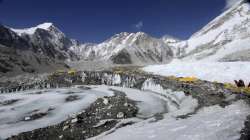Three million people in India at risk of flooding caused by glacial lake, claims new study
The study also estimated that at least 15 million people around the world are at risk from flooding caused by glacial lakes.

A recent study revealed that at least three million people in India are at risk of flooding caused by glacial lakes -- the maximum number of those exposed in the world. The study, conducted by an international team, was led by scientists at United Kingdom's Newcastle University. It also estimated that at least 15 million people around the world are at risk from flooding caused by glacial lakes.
The study, published in the journal Nature Communications, claimed that the UK is the first global assessment of areas at greatest risk of Glacial Lake Outburst Floods (GLOF). The researchers, which also identified priority areas for mitigation, said more than half the globally exposed populations are found in just four countries: India, Pakistan, Peru, and China.
India and Pakistan at maximum risk: Study
India and Pakistan contain the highest number of exposed people -- nearly three million and two million people respectively, or one-third of the global total combined -- while Iceland contains the least (260 people), they said. As the climate gets warmer, glaciers retreat and meltwater collects at the front of the glacier, forming a lake.
These lakes can suddenly burst and create a fast-flowing GLOF that can spread over a large distance from the original site -- more than 120 kilometres in some cases. GLOFs can be highly destructive and damage property, infrastructure, and agricultural land and can lead to significant loss of life.
Flash floods potentially triggered by a GLOF event in Uttarakhand’s Chamoli district in February 2021 left nearly 80 people dead and many more missing. The number of glacial lakes has grown rapidly since 1990 as a result of climate change. At the same time, the number of people living in these catchments has also increased significantly.
Basis of the research
The research team looked at 1,089 glacial lake basins worldwide and the number of people living within 50 kilometres of them, as well as the level of development in those areas and other societal indicators as markers of vulnerability to GLOFs.
They then used this information to quantify and rank the potential for damage from GLOFs at a global scale and assess communities' ability to respond effectively to a flood.
The results highlighted that 15 million people live within 50 km of a glacial lake and that High Mountain Asia -- which encompasses the Tibetan Plateau, from Kyrgyzstan to China -- has the highest GLOF danger, with 9.3 million people potentially at risk.
ALSO READ: Nearly 30,000 lives can be saved by improving 'road safety measures' in India: Study
"This work highlights that it's not the areas with the largest number or most rapidly growing lakes that are most dangerous. Instead, it is the number of people, their proximity to a glacial lake and importantly, their ability to cope with a flood that determines the potential danger from a GLOF event," lead researcher Caroline Taylor, a doctoral student at Newcastle University, said in a statement.
The researchers point to the relative lack of research on the danger from glacial lakes in the Andes, which runs along South America's western side, and is among the world's longest mountain ranges.
(With PTI inputs)